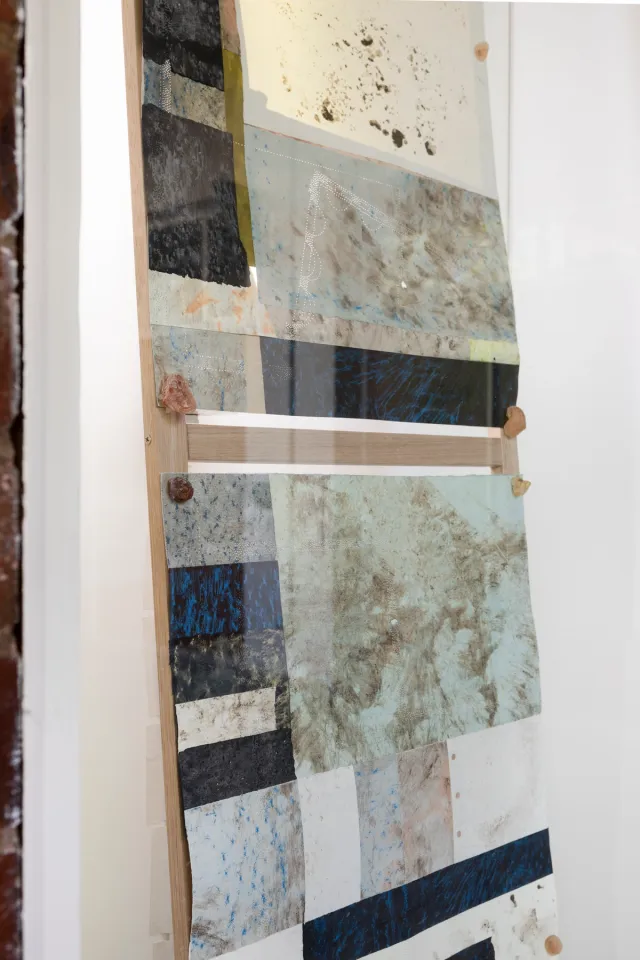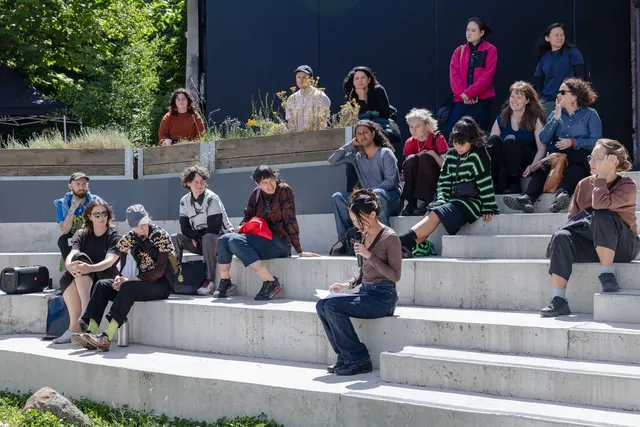“To touch or strike a fondant ground [south proposition]”
Abbra Kotlarczyk
19 Nov → 9 Jan 2023
Window

Abbra Kotlarczyk presents To touch or strike a fondant ground [north and south propositions] in the West Space Window.
This presentation is the second in a series of exhibition reading rooms centred around genealogy, familial history, material kinship, queer modes of reading and resistance. As a follow-up to A sonorous draft; a lexicon of windjamming (Blindside Gallery, 2021), this work takes up residence in the reading room and window exhibition spaces at Bus Projects (‘north proposition’) and West Space (‘south proposition’).
The co-hosting of this project at proximal, collaborative galleries within the Collingwood Yards—a former and current site for artistic pedagogy and trade located on stolen Wurundjeri land—gestures towards the architectural adjacencies and entangled histories of two bridgehead buildings in the Austrian city of Linz. These buildings—which in part house the Kunstuniversität Linz (University of Art and Design Linz) and a 2009 project by the German artist Hito Steyerl, Der Bau (The Building)—provide a direct material pathway to the artist’s paternal grandfather’s enslaved labours during World War II. From 1940 to 1945, Antoni Kotlarczyk worked as a wood-worker, mason-worker and seamstress in the Mauthausen-Gusen concentration camp complex, which took in the Wiener Graben granite quarry, established to furnish Adolf Hitler’s dream of making Linz the new neoclassical metropolis of the Danube river. As charted in Der Bau and Steyerl’s essay Aesthetics of Resistance, the Bridgehead Buildings, along with the Nibelungenbrücke (Nibelungen Bridge), were constructed from 1940 to 1943, in part by prisoners of war using granite from the Mauthausen-Gusen quarry.
It is believed, despite the opacity of intergenerational silence, that Antoni worked on this project along the banks of the Danube where these structures still exist today. The bridge and adjacent buildings were the only successful renditions of Hitler’s failed plans for the city of Linz.
As a site of intergenerational and material recuperation, this exhibition honours the artist’s grandfather’s labours during those years: of hands immersed in earth; of diligent tasks of stitching, incorporating, building. Against this history of brutal enforced labours rendering tyrannical monuments, these renditions envision new blueprints that dwell in the soft bodies of local Merri Creek clays and their vegetal and bacterial kin, as found around the artist’s home in Fawkner. Impressions of these bodies carried through papers and polymers both support and affectively divest from the holding of hard, intrusive rock used to fortify the colonial settler state of so-called Australia—the land to which Antoni migrated in 1949—thereby also foregrounding the difficult histories of our current sites for knowledge production.
The broader project to which this work belongs is conceived of as a mattered mode of inheritance and a symbolic genealogical bridge tethering the artist’s grandfather and non-biological children. This iteration takes up the premise of the strike in its various geological, human and political dimensions, as a mode of withdrawal from the corrupted determinisms of mastery and essentialist genealogies, and a nod to the literal work of stonemasonry and labour strikes. In considering what Claire Fontaine describes as the human strike “designating the most generic movement of revolt against any oppressive condition,” this work leans into iconic works of queer resistance—namely David Wojnarowicz’s Untitled (Face in Dirt) (1992-93) and Derek Jarman’s Blue (1993)—to assert the need for intimate, poetic fault-and-desire-lines to live in the after-and-present-lives of slavery. As Kathryn Yusoff writes,
"The violence of grammars of geology must…develop a mode of writing that speaks beyond the objecthood of geologic materiality to its inhuman and inhumane dimensions, as material praxis and subjective condition."
The West Space Window is supported by the City of Yarra through their Annual Arts Grants Program.






Abbra Kotlarczyk was raised on Bundjalung Country in the subtropical ruins of a decommissioned banana plantation. She has been finding ways to understand and communicate the tensions between bodies surviving off and with stolen lands, ever since. She makes art, curates, reads, writes, edits, parents and gardens—sometimes all at once—in an attempt to outmanoeuvre the forces that pit us against enmeshment. She currently lives and works on and around the unceded sovereign lands, waterways and skies of the Eastern Kulin nations in so-called Melbourne.